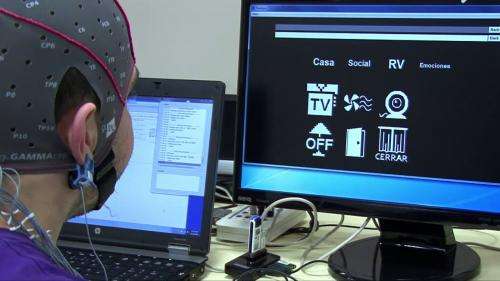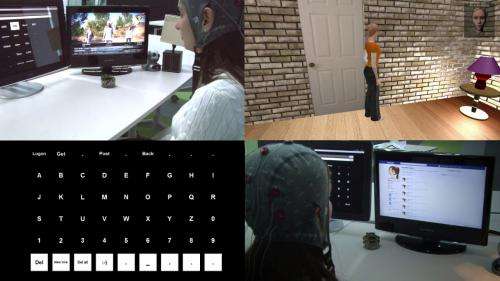New system interprets brain signals of people with disabilities, helps them to interact with their environment

The European R&D project BrainAble, led by Barcelona Digital and aimed at improving the autonomy of people with serious physical disabilities, has just successfully ended after three years of technological research and development with an investment of €3 million, partially funded by the European Commission under the FP7 Programme. BrainAble has demonstrated the benefits that advanced technologies bring to people with physical disabilities so severe that they cannot interact with their environment (home, friends, family, etc.) independently. Specifically, the project has developed a prototype that allows these people to perform actions that they could not otherwise, such as writing and communicating in social networks, turning on and off the light or the television, controlling any digital home appliance, like a wheelchair, and playing in and exploring virtual environments for their entertainment. And all this is possible simply by reading electrical brain signals, without moving a muscle.
This prototype consists of a combination of human-computer interfaces composed of Brain Computer Interface (BCI) sensors with other physiological sensors that measure a person's physical and emotional state (affective computing) and with virtual reality environments, and the connection of these interfaces with smart homes and online social networks. Thanks to this combination of technologies, the BrainAble prototype can read the brain impulses generated by the user to carry out a particular activity (for example, changing the television channel), interpret them and act on his/her behalf in the home or social environment. Furthermore, the system learns the user's habits and tries to understand the context in which they are being used, looking to automate some common actions (for example, regulating the temperature of the home according to the user's taste). It can also monitor whether the patient is tired, and if he/she is, it can adapt and become easier to use. Thus, by giving them more autonomy in their daily lives, the BrainAble system allows people with severe functional disabilities to improve their social inclusion and the quality of their lives.
Application and use of the BrainAble system
BrainAble was developed by a multi-disciplinary team of therapists, researchers and engineers on the frontier of neuroscience, signal processing, assistive technologies and automatic learning and is already having an impact on the growing market of accessible, inclusive and assistive products from an innovative perspective. Some of the members of the consortium are already studying how to incorporate the findings of the research into their BCI products, like the Austrian company Guger Technologies, and in the case of Barcelona Digital how to expand the range of application of the assistive technologies developed to other, larger groups like the elderly, as well as people with different types of disabilities.

In a society that is increasingly sensitive to dependency from a social and economic point of view, BrainAble is aimed at a growing market in the field of disability (190 million people around the world suffer from different degrees and types of functional disability, according to the WHO). Moreover, the adaptation of the technologies developed for BrainAble to make an active and independent life easier for the elderly and people with special needs of all kinds means that the potential for exploitation is very promising.
Thanks to the BrainAble project and its leadership of other forefront international technological projects, Barcelona Digital is positioned as a leader in creating and integrating assistive technologies in support for an active and independent life, and its transfer to the market.
Pilot tests and testimonial
"With BrainAble, I can do a series of tasks quickly and practically automatically. I would need a third person's help without it, given my reduced level of mobility. With this system, I am more autonomous and independent". These are the words of one of the patients with severe functional disability that tested the BrainAble prototype at the Guttmann Institute, a partner in the project and a leading centre for medical and surgical treatment and the comprehensive rehabilitation of people with spinal cord injury and acquired brain injury and other disabilities of a neurological origin.
Throughout implementation of the project, a total of 69 users with disabilities (patients and users of the AbilityNet centres and of the Guttmann Institute), in addition to other healthy users, individually tested and evaluated not just the various components of the system, but also the comprehensive prototype in a cycle of three iterations, from definition of the initial requirements to subsequent validation and continuous improvement of the developments.
Technological features of BrainAble
- The BCI systems use a helmet equipped with electrodes to capture the tiny electrical signals generated by the brain. Users are trained to generate signals that the system can translate into action.
- The incorporation of intelligence into the platform enables the system to understand the environment and the user's context and habits and can react in a proactive way.
- BrainAble's researchers have developed an application so the user can remotely control a robot with telepresence characteristics. They can manoeuvre the robot at home, perform different actions and even communicate with people, all without leaving bed.
- A similar technology allows the user to operate an avatar in a virtual reality environment, whether to practice controlling their wheelchair or home, or for social interaction.
- The platform also includes specific software that allows for simplified access to social network sites like Twitter and Facebook, which are becoming increasingly important tools for helping people with disabilities to overcome social isolation.
More information: Faller, J. et al. Prototype of a fully integrated auto-calibrating, context aware hybrid brain-computer interface for social inclusion and increased independence of individuals with severe functional disabilities, IEEE Engineering in Medicine and Biology Society (EMBC'12). www.bdigital.org/
Provided by Barcelona Digital Centre Tecnologic



















